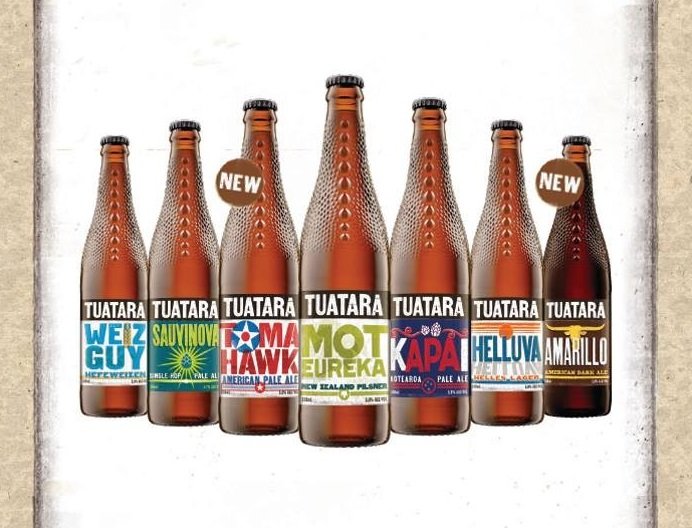
Some reptiles are well accustomed to ecdysis, shedding that remarkably crusty and creepy looking dead skin to continue its own healthy growth. Tuatara Brewery has also changed its skin, or labels, a number of times and is going as far as changing some brew names in a bid to stand out and continue brand growth.
When Tuatara Brewery began many consumers were clueless about craft beers, so the different brews’ features needed to be spelled out on the bottle. Sixteen years later New Zealanders have clued up on craft beers and the bottles need to respond to fierce competition in the beer kingdom.
Total sales of craft beer are up by 35 percent in the past year, as according to Statistics NZ, and ANZ estimate craft beer accounts for around 15 percent of domestic beer sales.
Now part of 168 craft breweries in New Zealand, Tuatara’s marketing manager, Melanie Percy, says the existing Tuatara branding needed to move forward with the ever-changing landscape of the craft beer market to make an impact.
“We all really loved the old branding and packaging, but we hadn’t touched it for 13 years, and it was beginning to look a little tired on the shelf, she says. “These days there’s are so many craft beers to choose from, and we just needed a little bit of a spruce up.”
The new packaging has a range of uniquely designed, stand out labels with bold contrasting colours. It’s on the same trajectory as previous packaging shake-ups, including the stand-out blue box that contained Aotearoa Pale Ale a few years back. It’s also held onto the wooden-craft aesthetic with it’s boxes to appeal to crafty-purchasers.
?
In a previous interview with Idealog, Tuatara founder Carl Vasta said: “We go to great lengths to put quality beer inside the bottle, so we thought we should put the beer in a great package to stand out from the crowd.”
Tuatara are no strangers to creative re-designs, having previously featured the vampires from Kiwi mockumentary Delicious Necks on its Immortal Pale Ale, creating a 3D label for Double Trouble, and giving its Black Light Stout label an ‘invisible ink’ update, to reveal a multi-coloured label under ultraviolet light.

Tuatara’s national sales manager, Blair Harley, sought feedback from Tuatara’s customers in the lead up to the brand refresh. “We were consistently hearing that as well as looking for interesting beer, craft beer drinkers were also very mindful of interesting names, packaging and tap badges – a visual story,” he says.
The new names create a fresh personality for the brews, to create some elbow-room from the 1500 unique craft beers also vying for shelf space.

The Bohemian Pilsner has been revamped as Mot Eureka, to symbolise its homegrown hops from Motueka in Nelson.
The Apa has found a new name in assonance, being converted to Kapai, which reflects the quintessential Kiwi-ness of the Aotearoa Pale Ale, and contains the original name within it.
Meanwhile, Helles Lager has gotten less serious. Now called Helluva to represent the adjective Tuatara hope will be used when the beverage is enjoyed at the end of a long, hot day.
The Kiwi undertones are deliberately clear in the new name stories as craft beers becoming increasingly New Zealand orientated. As ANZ’s New Zealand Craft Beer Industry Insights 2016 report found, retailers are becoming loyal to the styles of brew, rather than the brands, as competition increases.
The report reads: “The fastest moving style by some distance is Pale Ale in all its variants anecdotally accounting for as much as 65% of all New Zealand craft sales. Looking to how beverages like wines are merchandised, retailers are expressing interest in presenting beer by style.”
And this has not been lost on Tuatara, who have updated their Pilsner style. “When Carl first brewed a Pilsner, it was based on a Bohemian Pilsner in style,” says Percy. “Now our Pilsner is really a NZ Pilsner; it has all homegrown ingredients, and we just wanted to embrace and be proud of that, and reflect that personality of this beer with a name that is Kiwi and distinctive.”
She says the new names and style are a bold move seeing has some of the changes go against the grain of their heritage.
It’s not the only bold move Tuatara has made of late. The company recently attempted to trademark Amarillo, the new name for its New American Dark Ale which is also a common hop variety, as well as ‘Kapai’.
However, they quickly backed down after social media backlash called the brand out for unfair behaviour and it started to generate negative publicity.

As intellectual property expert and lawyer, Theodore Doucas of Zone Law and Zone IP commented: “While the courts can pass judgement, the consequences of angering the public can often be far more serious.”
But the Tuatara team is remaining optimistic as they enjoy positive feedback from the new branding. “So far, we have received fantastic feedback in terms of the styles in our core range and what they see,” says Harley.
Tuatara has also enjoyed tangible commercial success in the form of a Brewer’s Guild of New Zealand champion brewery award this year, along with plenty of awards for its individual brews.




